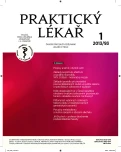Basics of social cognitive and affective neuroscience XXV. On happiness – the hedonic brain
Authors:
F. Koukolík
Authors‘ workplace:
Primář: MUDr. František Koukolík, DrSc.
; Národní referenční laboratoř prionových chorob
; Thomayerova nemocnice, Praha
; Oddělení patologie a molekulární medicíny
Published in:
Prakt. Lék. 2013; 93(1): 10-15
Category:
Of different specialties
Overview
Ever since Aristotle, happiness has been thought of as pleasure (hedonia) and a life well-lived (eudamonia). Substantial progress in understanding the neurobiology of sensory pleasure has been made. Interspecies pleasure research says that pleasure manifests in consciousness (subjective liking) and in brain and behavioural reactions (objective liking). Beyond the feeling of liking there are components of reward that contain wanting, motivation for reward and learning, associations, representations and predictions about future rewards. The “hedonic brain” is a description of the neuroanatomy of pleasure, a large scale neuronal network consisting of subcortical nuclei, eg. periaquaductal gray, ventral tegmental area, ventral palidum and nc. accumbens (ventral striatum) and of cortical parts, orbitofrontal, cingulate, medial frontal and insular cortices. Pleasure, eudamonic happiness, may arise due to the function of brain’s default system.
Keywords:
reward – pleasure – hedonic brain
Sources
1. Aldridge JW, Berridge KC. Neural coding of pleasure: „rose-tinted glasses“ of the ventral pallidum. In: Kringelbach ML, Berridge KC. (eds.) Pleasures of the brain. New York: Oxford University Press 2010; 62–73.
2. Beckman M, Johansen-Berg H, Rushworth MFS. Connectivity-based parcellation of human cingulate cortex and its relation to functional specialization. J Neurosci 2009; 29 : 1175–1190.
3. Berridge KC, Robinson TE. Parsing reward. Trends Neurosci 2003; 26 : 507–513.
4. Berridge KC, Kringelbach ML. Building a neuroscience of pleasure and well-being. Psychol Well-Being Theory Res Pract 2011; 1(3): 1–26.
5. Blood AJ, Zatorre RJ. Intensely pleasurable responses to music correlate with activity in brain regions implicated in reward and emotion. Proc Natl Acad Sci USA 2001; 98 : 11818–11823.
6. Buckner R, Andrew-Hanna J, Schacter D. The brain´s default network: anatomy, function and relevance to disease. Ann NY Acad Sci 2008; 1124 : 1–38.
7. Carmichael ST, Price JL. Architectonic subdivision of the orbital and medial prefrontal cortex in the macaque monkey. J Comp Neurol 1994; 346 : 366–402.
8. Craig AD. How do you feel – now? The anterior insula and human awareness. Nat Rev Neurosci 2009; 10 : 59–70.
9. Damasio AR. The somatic marker hypothesis and the possible functions of the prefrontal cortex. Phil Trans R Soc B: Biol Sci 1996; 351 : 1413–1420.
10. Damasio A. Hledání Spinozy. Radost, strast a citový mozek. Praha: Dybbuk 2004 (přel. F. Koukolík).
11. Drevets WC, Price JL, Furey ML. Brain structural and functional abnormalities in mood disorders: implications for neurocircuitry models of depression. Brain Struct Funct 2008; 213 : 93–118.
12. Frijda N. On the nature and function of pleasure. In: Kringelbach ML, Berridge KC. (Eds.) Pleasures of the brain. New York: Oxford University Press 2010; 99–112.
13. Georgiadis JR, Kortekaas R, Kuipers R, et al. Regional cerebral blood flow changes associated with clitorally induced orgasms in healthy women. Eur J Neurosci 2006; 24 : 3305–3316.
14. Hornak J, Bramham J, Rolls ET, et al. Changes in emotion after circumscribed surgical lesions of the orbitofrontal and cingulate cortices. Brain 2003; 126 : 1671–1712.
15. Koukolík F. Evoluce a evoluční teorie pro lékaře X. Sebeuvědomování. Prakt. Lék. 2010; 90 : 571–576.
16. Koukolík F. Lidský mozek. Funkční systémy. Norma a poruchy. Třetí, přepracované a doplněné vydání. Praha: Galén 2012; 220–224.
17. Kesebir P, Diener E. In pursuit of happiness: empirical answers to philosophical questions. Perspect Psychol Sci 2008; 3 : 117–125.
18. Kringelbach ML, O´Doherty J, Rolls ET, et al. Activation of the human orbitofrontal cortex to a liquid food stimulus in correlated with subjective plesantness. Cereb Cortex 2003; 13 : 1064–1071.
19. Kringelbach ML. The human orbitofrontal cortex: linking reward to hedonic experience. Nat Rev Neurosci 2005; 6 : 691–702.
20. Kringelbach ML, Berridge KC. Towards a functional neuroanatomy of pleasure and happiness. Trends Cogn Sci 2009; 13 : 479–487.
21. Kringelbach ML. The hedonic brain: a functional neuroanatomy of human pleasure. In: Kringelbach ML, Berridge KC. (Eds.) Pleasures of the brain. New York: Oxford University Press 2010 : 202–221.
22. Laureys S, Owen AM, Schiff ND. Brain function in coma, vegetative state, and related disorders. Lancet Neurol 2004; 3 : 537–546.
23. Miller JM, Vorel SR, Tranguch AJ, et al. Anhedonia after selective bilateral lesion of the globus palidus. Am J Psychiatry 2006; 163 : 786–788.
24. Pessiglione M, Schmidt L, Draganski B, et al. How the brain translates money into force: a neuroimaging study of subliminal motivation. Science 2007; 11 : 904–906.
25. Small DM, Zatorre RJ, Dagher A, et al. Changes in brain activity related to eating chocolate. From pleasure to aversion. Brain 2001; 124 : 1720–1733.
26. Smith KS, Mahler SV, Pecina S, et al. Hedonic hotspots : generating sensory pleasure in the brain. In: Kringelbach ML, Berridge KC. (eds.) Pleasures of the Brain. New York: Oxford University Press 2010 : 27–49.
27. Smith KS, Berridge KC, Aldridge JW. Disentangling pleasure from incentive salience and learning signals in brain reward circuitry. Proc Natl Acad Sci 2011; 108: E255–E264.
28. Steiner JE, Glaser D, Hawillo ME, et al. Comparative expression of hedonic impact: affective reactions to taste by human infants and other primates. Neurosci Biobehav Rev 2001; 25 : 53–74.
29. Völlm BA, de Araujo IE, Cowen PJ, et al. Methamphetamine activates reward circuitry in drug naive human subjects. Neuropsychopharmacology 2004; 29 : 1715–1722.
30. WHO. The world health report (2001). Chap 2,4. Dostupné na: www.who.int/entity/whr/2001/en/whr01_en.pdf
Labels
General practitioner for children and adolescents General practitioner for adultsArticle was published in
General Practitioner

2013 Issue 1
Most read in this issue
- Oral manifestations of anaemia
- Metabolic and nutritional disorders associated with alcohol abuse
- The basic rules for providing occupational health services by the law concerning specific health services
- Basics of social cognitive and affective neuroscience XXV. On happiness – the hedonic brain
